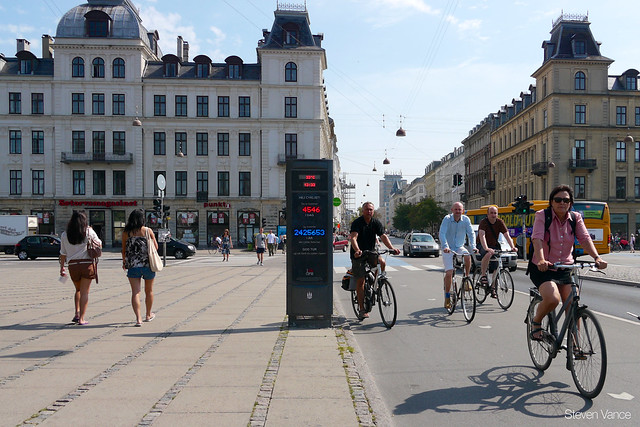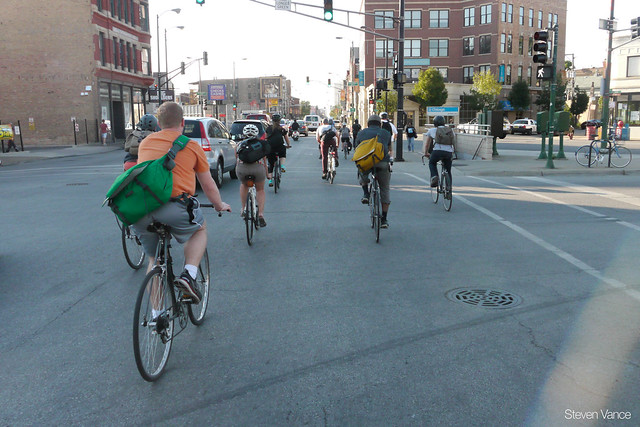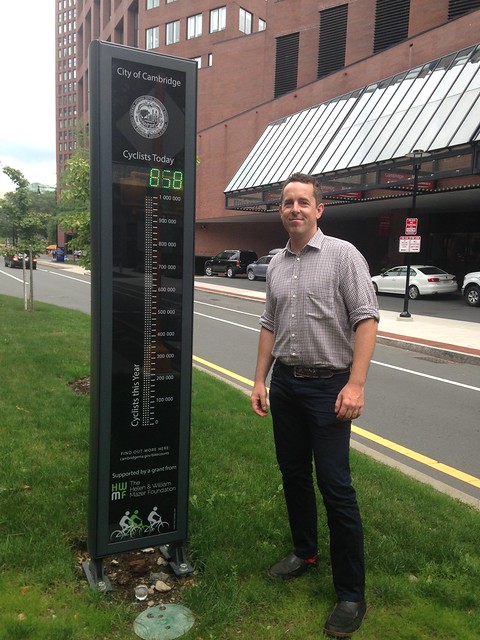When I visited the Boston area last month, I saw a Copenhagen-style bike counter on a Cambridge boulevard. It occurred to me that installing one of these devices could help boost safety on Milwaukee Avenue, Chicago’s heavily cycled “Hipster Highway.”
The Chicago Department of Transportation has been steadily making improvements to this popular route between the Loop and bike-friendly Northwest Side neighborhoods – the city’s busiest cycling street. They’ve put in a mix of buffered and protected bike lanes on Milwaukee between Kinzie Street (the avenue’s southern terminus) and Division Street.
However, the 0.8-mile section of Milwaukee between Division and North in Wicker Park is the one that’s crying out for bike improvements. It has tons of shops, restaurants, cafes, and bars – prime cycling destinations.
However, this right-of-way on this segment is currently too narrow for proper bike lanes, so it only has “sharrows” – bike symbols with chevrons. The combination of high bike traffic, frequent parking turnover, and tight quarters has led to an epidemic of dooring crashes in recent years, including at least one nearly fatal incident.
The Active Transportation Alliance and others have floated the idea of stripping parking from one side of this stretch to make room for protected bikeways, which would go a long way towards eliminating doorings. 32nd Ward Alderman Scott Waguespack even asked the Wicker Park Committee neighborhood group to take an advisory vote on whether this would be an acceptable solution.
The committee shot down the idea with a 15-8 vote. “"It would kill the merchants,” bar owner Kevin O’Donnell told DNAinfo. “For the sake of bikes you're disturbing vehicle and pedestrian traffic.”
That’s where the bike counter idea comes in. Past CDOT counts, conducted using volunteers, have shown that cyclists have account for more than 40 percent of trips on Milwaukee during summer rush hours.
Keeping a continuous, accurate count of bike trips would give us a better idea of whether it would make sense to reallocate the street space for protected lanes, or some other kind of bikeway. And advertising that count via a highly visible device with a lit-up display would let residents and merchant know that cyclists up a big percentage of the people who travel and spend money on Milwaukee, which would build support for the street remix.
Assuming the bike counter is a good idea, how can we make this happen? The devices have already been installed in a number of bike-friendly U.S. cities like San Francisco, Seattle, Portland, Oregon, and Boulder, Colorado. Cambridge’s counter cost about $27,000, which was funded by the Helen & William Mazer Foundation, based in New Jersey.
The model, which is called an Eco-TOTEM, is made by the Montreal-based company Eco-Counter. Sales rep Danielle Dhiab told me that, while the price varies depending on features, the $27K figure is typical for the two-sided model. They don’t offer a solar-powered option, so the Cambridge device is plugged into the city’s power grid.
The Eco-Totem can also be used to count cars and pedestrians, Dhiab said. To detect bikes and autos, loops are installed in the roadway which differentiate between the types of vehicles based on the amount of metal, wheelbase, speed, and other factors. Infrared sensors are used to count people on foot.
At a time when Chicago mayor Rahm Emanuel has proposed record tax hikes to help balance the budget, spending city money on a bike counter would surely be a non-starter, but federal transportation grants might be a possibility. Since Milwaukee is such a popular route for cyclists, it might even be possible to bankroll the device through crowd-funding.
CDOT spokesman Mike Claffey indicated that the agency is open to a counter being installed on Milwaukee. “We are always looking to improve our ability to collect data and open to explore new ideas,” he said. "But there’s nothing specific we can say about it right now.”
However, a source told me that the Hipster Highway Bike Counter may already be a project under consideration. We’ll try to find out more and hopefully provide an update soon.







